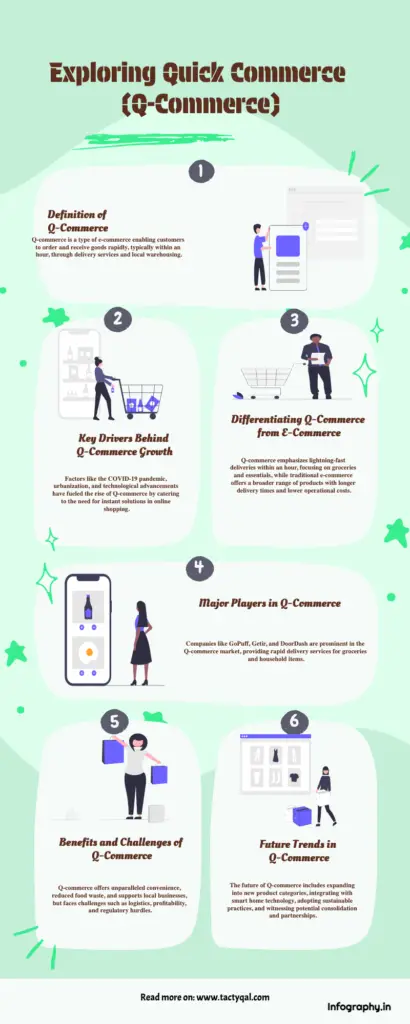What is Quick Commerce or Q-Commerce? And How Is It Different From Ecommerce?
Today we’re going to dive into something that’s taking the world of online shopping by storm – quick commerce, or as the cool kids call it, q-commerce.
If you’re an entrepreneur or just someone who loves to stay ahead of the curve, this is a topic you can’t afford to miss. Q-commerce is shaking up the way we think about convenience, instant gratification, and the future of retail.
What is Q-Commerce?
Q-commerce, short for quick commerce, is a new form of e-commerce that promises lightning-fast delivery of goods, often within an hour or less. It’s like having a personal shopping assistant who can teleport your desired items right to your doorstep in the blink of an eye.
Here’s how it works: You open an app on your smartphone, browse through a selection of everyday essentials like groceries, household supplies, or even prepared meals, and place your order. Then, like magic, a delivery person (sometimes on a bike or scooter) arrives at your location with your items in record time.
Q-commerce, or quick commerce, is a type of e-commerce that allows customers to order and receive goods within a short period, typically within an hour or less, through the use of delivery services and local warehousing or “dark stores.”
The Rise of Q-Commerce
Now, you might be thinking, “Wait a minute, isn’t this just another fancy term for food delivery?” Well, yes and no. While food delivery services like Grubhub and DoorDash paved the way for instant gratification in the realm of prepared meals, q-commerce takes things a step further.
Key Driving Forces Behind Q-Commerce Growth
- The COVID-19 Pandemic: With lockdowns and social distancing measures in place, people became more reliant on online shopping and delivery services than ever before. This shift in consumer behavior opened the door for q-commerce to thrive.
- Urbanization: As more people flock to cities, the demand for convenient and efficient shopping solutions has skyrocketed. Q-commerce caters perfectly to the needs of urban dwellers with limited time and space.
- Technological Advancements: Advances in logistics, inventory management, and delivery infrastructure have made it possible for q-commerce companies to operate efficiently and scale quickly.
Quick Commerce vs E-Commerce
Here’s a table comparing quick commerce (q-commerce) and traditional e-commerce:
| Feature | Q-Commerce | E-Commerce |
|---|---|---|
| Delivery Speed | Within 1 hour or less | A few hours to several days |
| Product Range | Focused on groceries, household essentials | Vast range across categories |
| Delivery Model | Local dark stores/micro-fulfillment centers, delivery workforce | Centralized warehouses, mainstream logistics |
| Order Size | Optimized for smaller baskets, immediate needs | Can accommodate both small and large orders |
| Operational Costs | Higher due to local infrastructure and rapid delivery | Relatively lower, economies of scale |
| User Experience | Highly convenient, instant gratification | Convenient but longer delivery times |
| Profitability Challenges | Difficult due to high costs | Established players have achieved profitability |
This table highlights the key differences between the two models, with q-commerce prioritizing speed and convenience for instant needs, while e-commerce offers a broader product range and generally longer delivery times, albeit with lower operational costs and established profitability models.
Key Players in the Q-Commerce Game
While q-commerce is still a relatively new concept, several companies have already made significant strides in this space. Let’s take a look at some of the major players:
Rapid Delivery Services
- GoPuff: Founded in 2013, GoPuff is often considered the pioneer of q-commerce. Operating in over 1,000 cities across the U.S. and Europe, they deliver a wide range of products, from snacks and drinks to household essentials and over-the-counter medications.
- Getir: Hailing from Turkey, Getir has expanded its operations to several European countries and the U.S. They offer a similar range of products as GoPuff, with a focus on speedy delivery.
- Gorillas: Based in Berlin, Gorillas has raised significant funding and is rapidly expanding across Europe and the U.S., offering a diverse selection of groceries and household items.
- DoorDash: In addition to food delivery, DoorDash has expanded into q-commerce with their DashMart service, offering grocery and convenience items delivered in under an hour.
- Jokr: A New York-based q-commerce startup, Jokr promises delivery of a wide range of products, including groceries and household items, in under 15 minutes.
- Blinkit (formerly Grofers): One of the pioneers of q-commerce in India, Blinkit operates dark stores across multiple cities, delivering groceries and essentials in under 20 minutes.
- Dunzo: Initially launched as a task runner service, Dunzo has expanded into q-commerce, offering rapid delivery of groceries, food, and other essentials.
- Swiggy Instamart: Food delivery giant Swiggy has ventured into q-commerce with Instamart, delivering groceries and household items within an hour.
- Zepto: A relatively new player, Zepto promises delivery of groceries and other essentials in under 10 minutes across several Indian cities.
- BigBasket BB Daily: The online grocery platform BigBasket has introduced BB Daily, offering quick delivery of fresh produce and essentials within 60-90 minutes
Traditional Retailers Jumping on the Q-Commerce Bandwagon
- Target: The retail giant has partnered with Shipt to offer same-day delivery on a wide range of products, including groceries and household essentials.
- Walmart: Through their partnership with Delivery.com, Walmart offers Express Delivery, promising to deliver select items in as little as two hours.
Benefits of Q-Commerce
Now, you might be wondering, “Why should I care about q-commerce? Isn’t it just another fad?” Well, let me tell you, my friend, q-commerce offers some pretty sweet benefits that make it worth paying attention to.
1. Unparalleled Convenience
Let’s face it; we live in a world where time is precious, and convenience is king. Q-commerce eliminates the need for time-consuming trips to the grocery store or waiting days for online orders to arrive. With just a few taps on your phone, you can have everything you need delivered straight to your doorstep in a flash.
2. Reduced Food Waste
Have you ever bought a bunch of fresh produce, only to have it go bad before you could use it all? With q-commerce, you can order exactly what you need, when you need it, reducing food waste and saving money in the process.
3. Supporting Local Businesses
Many Q-commerce companies partner with local retailers and suppliers, helping to support the local economy and reduce the carbon footprint associated with long-distance shipping.
Challenges Facing Q-Commerce
Of course, like any new and disruptive technology, q-commerce isn’t without its challenges. Let’s take a look at some of the hurdles it needs to overcome:
Logistics and Infrastructure
Delivering goods within an hour or less requires a well-oiled logistics and delivery infrastructure, which can be challenging and expensive to set up, especially in densely populated urban areas.
Profitability Concerns
With the high costs associated with rapid delivery and the need to maintain local warehouses or “dark stores,” achieving profitability can be a significant challenge for Q-commerce companies.
Regulatory Challenges
As q-commerce expands, it may face increased regulatory scrutiny, particularly regarding labor practices, zoning laws, and environmental impact.
The Future of Q-Commerce
Despite the challenges, the future of q-commerce looks bright and full of opportunities. Here are a few trends and predictions worth keeping an eye on:
Expansion Beyond Groceries
While q-commerce initially focused on delivering everyday essentials like groceries and household items, we’re likely to see an expansion into other product categories, such as apparel, electronics, and even furniture.
Integration with Smart Home Technology
As smart home devices become more prevalent, q-commerce companies may offer seamless integration, allowing you to reorder supplies or replenish household items with just a voice command.
Sustainable and Eco-Friendly Practices
To address environmental concerns, q-commerce companies may adopt more sustainable practices, such as using electric vehicles for deliveries, implementing more efficient routing algorithms, and reducing waste through better inventory management.
Potential for Consolidation and Partnerships
As the q-commerce market matures, we may see consolidation among smaller players, as well as partnerships between q-commerce companies and traditional retailers or delivery services.
TL;DR
In a nutshell, q-commerce, or quick commerce, is a revolutionary new form of e-commerce that promises lightning-fast delivery of everyday essentials, often within an hour or less. While still in its early stages, q-commerce offers unparalleled convenience, reduces food waste, and supports local businesses.
However, it also faces challenges such as logistics, profitability, and regulatory hurdles. Nonetheless, the future of q-commerce looks promising, with potential expansions into new product categories, integration with smart home technology, and a focus on sustainable and eco-friendly practices.
So, whether you’re an entrepreneur looking for the next big opportunity or just someone who values convenience and instant gratification, keep an eye on q-commerce – it might just be the future of online shopping.

Related Posts







